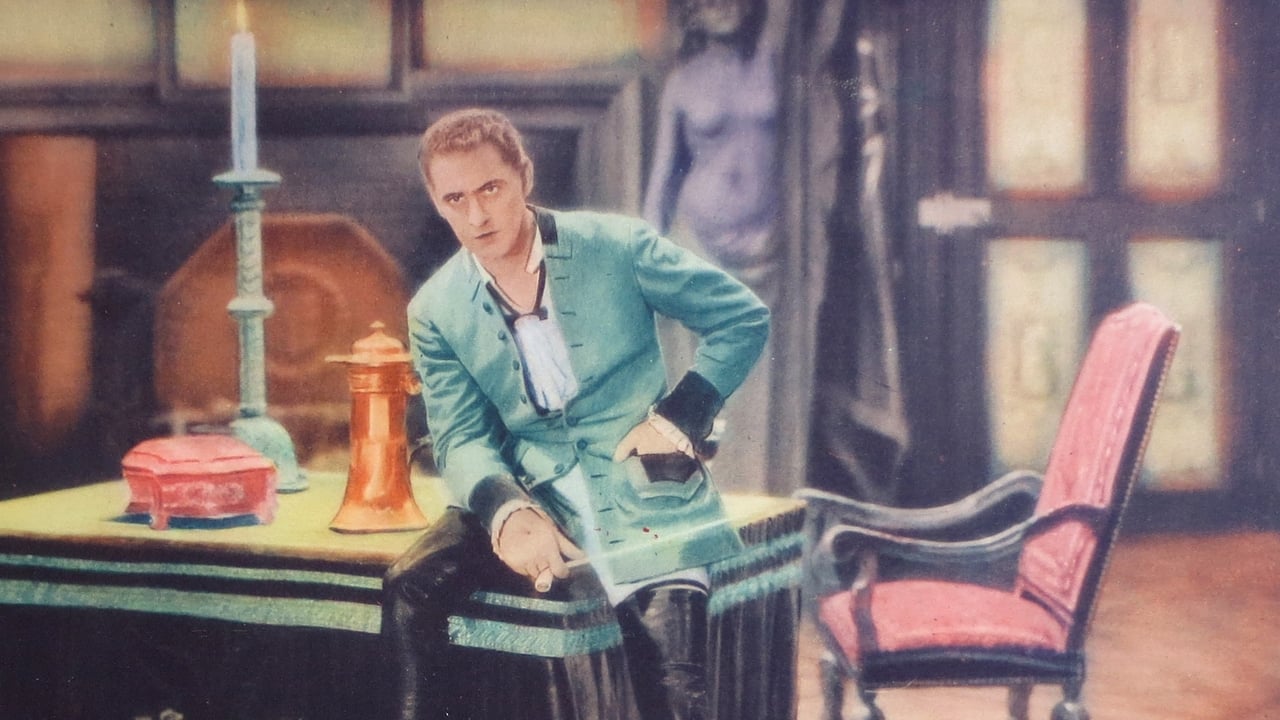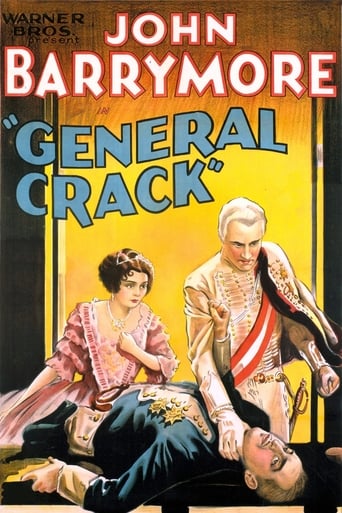

The version i saw was a good print of the silent version,but it look like it was shot form a t.v. in a darken room,causing a t,v flicker and the image on the top and bottom and sides dark.The finally that was in technicolor ,right after John Barrymore discovers that ,the new invader of his land ,as the duke of Kurland , was the women he was in love with played by Marion Nixon,who plays the sister of Lowell Sherman,who plays Leopold the second,in which she state to him that she cannot rule alone,that was suppose to proceed with the color sequence finally ,but,that is lost.Worst the dialog version has been lost too.This is the silent print possibly for theater that did not have talking equipment.This of course is better than nothing.It is almost the whole film except the finally and ending credits. You still understand it.In spite of Armita,who plays the gold digging Gypsy dancers ,that Barrymore marries,And later learned that she was not been. faithful.Was having an affair with Lowell Sherman's character and lowell Sherman and Marion Nixon being muted and inter titled,their performances come out right.John Barrymore was excellent in spite of his silents in playing the bastard son of the original duke of Kurland,whom he also played his father ,the prince's mother was a gypsy.John plays a solider,prince Christian fighting for Austria against Belgium,but,he gets screwed up by Leopold ,when he find out Armita was having a fling with Leopold .He almost has Leopold hang d,until his sister played by Marion Nixon,whoio's in love with Christian ,persuade him no too.Hobart Bosworth is good ,even though you don't hear him ,as Count Hensdorff.Even though it's not complete it's still watchable.You can still understand it.03/9/18
... View MoreThe film's prologue has the Duke of Kurland (JB must have loved this part as he gets made up to be old!) holding a banquet for his officers and is bemoaning his lack of an heir when a ragged boy enters the hall and identifies himself as Christian, the duke's son by a gypsy princess now dead. This has a great part for the young boy (played by Philippe De Lacy who also played the young Don Juan age 10 with Barrymore) as he gets to slap Barrymore's face!! Twenty years later, Prince Christian is a powerful leader, a soldier of fortune and known as GENERAL CRACK (BARRYMORE). When compelled by Leopold II (Lowell Sherman) to offer his services, Christian demands a high price in gold and the hand of the Archduchess Maria Luisa (Marian Nixon), when he overhears court gossip saying the Emperor forbid his sister to meet General Crack as she could never meet his mother!! Back at his headquarters and within the deadline of 3 days, the Emperor agrees to GENERAL CRACK's terms.Enroute to Vienna, he encounters Fidelia (Armida), a spirited gypsy dancer and under the spell of gypsy lore, he tells his men to ride on without him saying he has been "unavoidably detained". 3 days after keeping the Emperor and Archduchess waiting, he rides back to Vienna. At court he announces the reason for his delay and proudly introduces his wife, Fidelia! Maria Luisa is the first to congratulate them and GENERAL CRACK is astounded at her kindness and beauty. They are guests of Leopold and he becomes infatuated with Fidelia at a court celebration. Colonel Gabor (Otto Matieson) is GENERAL CRACK'S most trusted aid and he makes it known to the Emperor that he could also be his! (Unfortunately, there's a small scene here on a Balcony where Fidelia is talking to Gabor but then it jumps to GENERAL CRACK talking to Fidelia on the balcony. From images of Lobby Cards, photos etc, General Crack is trying to strangle Gabor over the Balcony, so one can only presume what Gabor was saying or getting up to with Fidelia!) The night before GENERAL CRACK goes away to war, he gives Fidelia a necklace and asks her if she still remembers what her name means? Fidelia says it means Faithful but why do you ask? While GENERAL CRACK is away at war, Leopold forces his attentions on the bride and now a vengeful Colonel Gabor, arrives at GENERAL CRACKS's headquarters to tell him that he watched the Emperor enter Fidelia's chamber and stayed there all night. GENERAL CRACK tells him he'll have him flogged if he mentions his wife's name again but when Gabor produces the necklace GENERAL CRACK gave to Fidelia, GENERAL CRACK flies for Gabor and silence him by gagging and taping his mouth. The Emperor arrives at GENERAL CRACK's base and is just in time to watch Gabor being executed. He asks GENERAL CRACK what is the reason and GENERAL CRACK tells him 'for saying something that should never be heard about the Emperor and his wife'. The Emperor sees the necklace in GENERAL CRACKS hand and realises he knows. GENERAL CRACK then returns to the Emperor's palace in Vienna to see Fidelia just as she is posing for a painting dressed in her gypsy costume, which she thinks will please him. However, he sends her back to her gypsy tribe. Returning back to war and winning Brussels for Leopold, he tells him that although he promised he would win him the crown he doesn't intend to keep it there! Ever more powerful GENERAL CRACK's army then takes over and Leopold and Maria Luisa become fugitives. However, they are found, captured and brought to him. GENERAL CRACK tells The Emperor that he must balance the books but unfortunately he doesn't have a wife! Leopold is taken away and Luisa is left alone with GENERAL CRACK. (Now this is one of my favourite scenes in the film.) GENERAL CRACK tells Luisa that gypsies have a quaint custom - an eye for an eye, a tooth for a tooth! He then forcefully kisses Luisa but she slowly puts her arms around him. (I thought this kiss/embrace shows much more passion than the famous Sea Beast kiss!) Mystified by her reaction, she tells him that she loves him. Alas, his revenge has fallen flat on his face and he lets the Emperor and Archduchess free. Returning back to his seat as Duke of Kurland, GENERAL CRACK accepts Maria Luisa's offer to be elevated as Archduke of Kurland. The film was shot immediately after he and DOLORES COSTELLO returned from their honeymoon cruise. Barrymore looks wonderful in this film even though he was drinking heavily and was hospitalised during the shooting for an ulcer. There are some wonderful profile and posing shots of Barrymore, and again he's added a few of his own comic mannerisms to the film, which made me laugh!! (If you KNOW Barrymore, you'll KNOW what I mean!) No doubt, copies of this film will eventually get around so hopefully everyone can enjoy it as much as I do.
... View MoreI'll explain the weird title first: John Barrymore stars as a European prince named Christian Rudolf Augustus Christopher Ketler. When he goes off to war, he combines the initials of his five names into an acronym and calls himself 'General Crack' ... but Barrymore and most of the other cast members in this movie are playing characters whose first language would be German, so we don't know if Barrymore's character is aware of all the English-language (and Irish) implications of the word 'Crack'. I viewed a very bad print of 'General Crack' which was seriously deteriorated. The film is mostly black-and-white, but contained a colour sequence which is supposed to take place at the palace of the Archduchess Maria of the Holy Roman Empire: this sequence was almost completely deteriorated, so I can't comment on it, and I may have missed a few plot points elsewhere in the movie. This film takes place in Europe, a couple of decades before the Crimean War. Barrymore plays a Graustarkian prince. For reasons which I failed to catch, he marries a sloe-eyed Romany (Gypsy) girl named Fidelia. This is completely implausible: in those days, a nobleman couldn't possibly marry a commoner (much less a Gypsy) and hope to retain his title. Look what happened to Edward VIII, a hundred years later. When Fidelia betrays him (she should have changed her name to Infidelia), Crack abandons her and marries Archduchess Maria. Royal intrigues ensue, none of them very interesting and all of a sub-Mayerling nature. I suppose that 1930 audiences went to this movie to hear Barrymore's voice and to see him play romantic scenes. On those counts, he doesn't disappoint. The soundtrack is poor but it conveys Barrymore's rich baritone voice and splendid diction. In this movie, he spends a lot of time pitching woo to beautiful actresses, exhibiting his famous profile while wearing elaborate military uniforms, and generally buckling his swash. As the (not arch enough) Archduchess, Marian Nixon is quite pretty and delicate but she utterly fails to convey the dignity and authority that such a personage would possess. We can't accept that she's been trained from birth for this high position. Otto Matieson is excellent in a supporting role. Julanne Johnston is attractive, and she steals one scene very effectively. I shan't rate this film, as the print which I viewed was badly damaged and incomplete. But Barrymore's considerable talent shines through. Despite its howlingly unlikely plot, this may well have been an excellent movie.
... View More